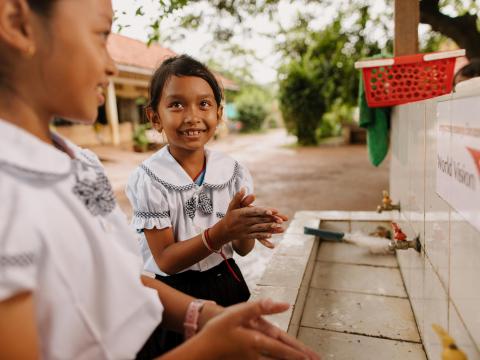Public Statement: Improving Reading Habits through Increasing Quality of School Libraries
Download
Phnom Penh, 12 March, 2017 – World Vision celebrated the country’s second National Reading Day (11 March) with 4,052 students in 43 schools across its 9 target provinces (Banteay Meanchey, Battambang, Kampong Chhnang, Kampong Speu, Kampong Thom, Kandal, Preah Vihear, Siem Reap, and Takeo). Local authorities, school directors, parents and students actively participated in the event, with speeches to inform people about why reading is important, adults reading aloud to children and children reading aloud to their peers, and gifts given to children who read especially well. A main activity during the half-day event was that the grade 1-6 students had the opportunity to dialogue with their school directors and teachers to discuss the condition of and access to their own school library. Students then voted for the one top library standard that they want to be improved among ten library standards (taken from MoEYS library standards for Primary School in 2011).
According to the consolidated results from all nine provinces, the top 3 prioritised library standards students wanted to improve include: (1) increasing the amount and variety of books and reading materials for students to read and borrow (25%); (2) ensuring a conducive library environment (12%); and (3) conducting reading activities in the library (10%). These results confirmed the research findings from World Vision’s 2016 “Current Situation and Use of Primary School Library: A Snapshot across 5 Provinces of Cambodia” and “Reading Environments & Habits of Students in Grade 4 to 6”.
World Vision’s research suggested that school libraries that meet the Government’s “Standards for Primary School Library” correlate with better reading habits. However, many libraries are struggling to meet the government’s minimum standards, especially in terms of number and type of books available for children to read and borrow. Only one-quarter of schools have the minimum amount of books and reading resources and just one-third of students reported to consistently find what they were looking for in the library. World Vision’s studies also showed that while children may have sufficient access to libraries, in many cases they lack stimulating reading-related activities that are critical for consolidating reading skills and increasing students’ enjoyment of reading and learning (such as storytelling, reading aloud, and literacy games).
It is interesting to note that though the majority of libraries allowed students to read books independently during general opening hours or during specified library times, almost half of the students surveyed said they never borrowed anything from the library. The most common reason given was that students were concerned about losing or damaging the books, a concern strongly reinforced by librarians and/or teachers. There were also suggestions from students to improve the cleanliness, hygiene, decoration of the library to increase library usage.
World Vision would like to acknowledge and congratulate the Royal Government of Cambodia for the good progress made towards improving access to and quality of education in Cambodia. To improve reading habits for children in Cambodia, World Vision is calling on the Royal Government of Cambodia to:
- Increase the variety, diversity and quantity of reading materials available at libraries. These materials should be different from textbooks and storybooks which currently comprise the bulk of library materials
- Better coordinate with sub-national structures to ensure that monitoring of school services, including library service, is done regularly, and followed up with tangible action points and support for schools to meet the 2011 MoEYS Standards for Primary School Library.
- Invest in the skills training of librarians so they can better manage library resources and enhance the effectiveness of the library service – through improving library environment, increased storytelling, encouraging borrowing of books (to read at home and outside the library), and supporting children to make best use of the library resource for learning.



